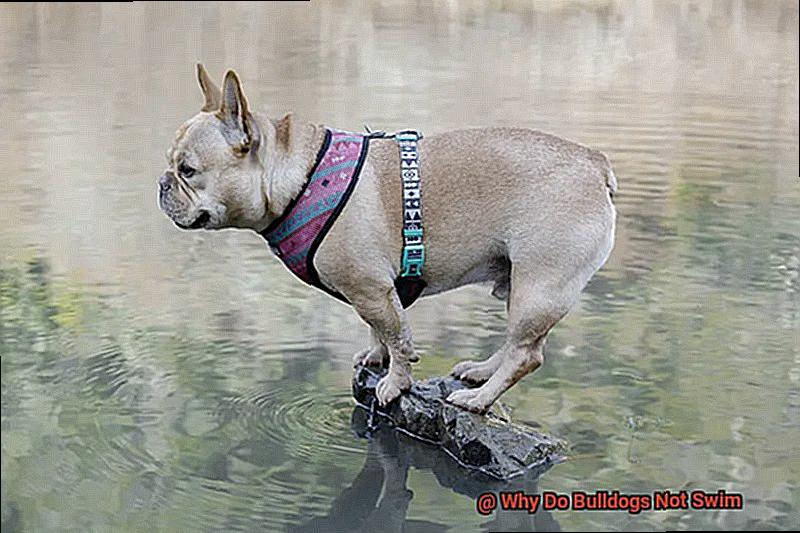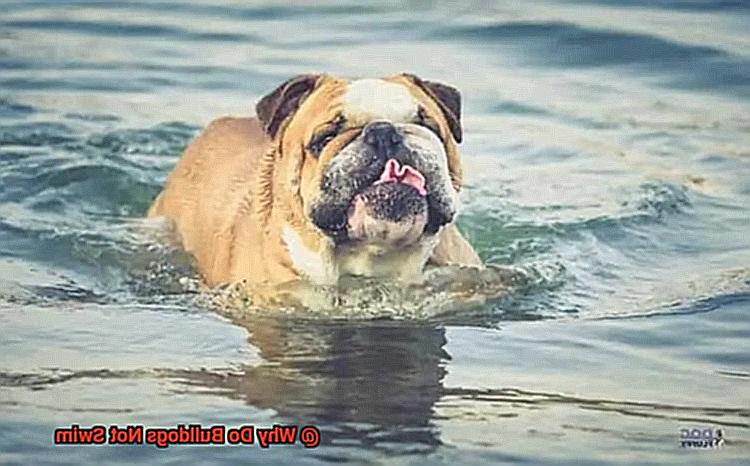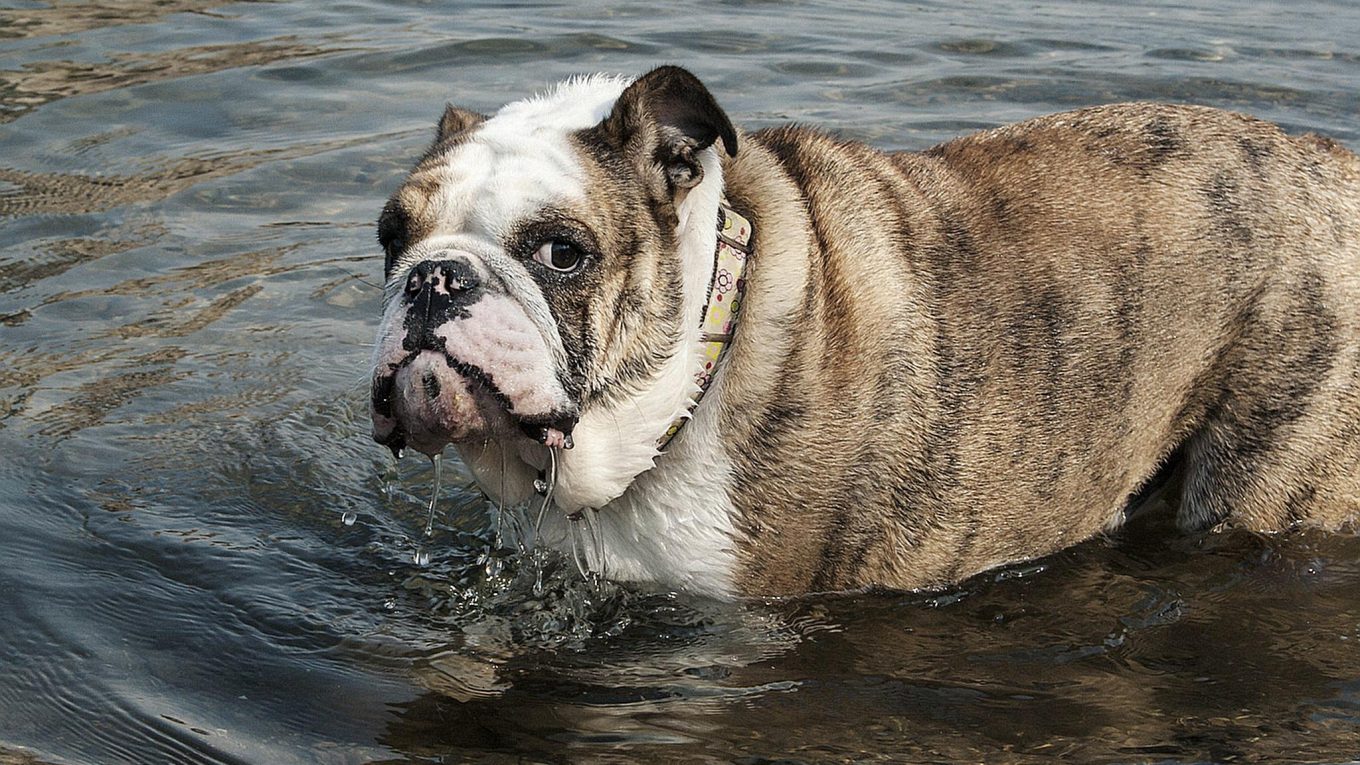Why Do Bulldogs Not Swim?
They may have the strength of a Mastiff and the charm of a teddy bear, but when it comes to swimming, bulldogs are notorious for their aversion to water.
Despite their muscular build and love for outdoor adventures, these lovable canines seem to have a strong dislike for taking a dip. But why is that?
In this blog post, we will unravel the mystery behind bulldogs’ lack of enthusiasm for swimming. From their physical limitations to their genetic predispositions, we will uncover the truth about this unique trait.
So grab your favorite beverage and join me as we explore the world of bulldogs and water – you might just learn something new about these adorable creatures.
Why Do Bulldogs Not Swim?
Contents
- 1 Why Do Bulldogs Not Swim?
- 2 Physical Characteristics That Affect Swimming Ability
- 3 The Lack of Swimming Instinct in Bulldogs
- 4 Overcoming Fear of Water in Bulldogs
- 5 Health Concerns and Risks Associated with Swimming for Bulldogs
- 6 Safety Precautions for Bulldogs Around Water
- 7 How to Introduce Your Bulldog to Swimming
- 8 Conclusion
As a proud bulldog owner, you may have noticed that your furry friend is not the most enthusiastic swimmer. While other breeds like Labradors and Retrievers are known for their love of water, bulldogs seem to have a natural aversion to swimming. But have you ever wondered why? As an expert on the topic of bulldogs, I am here to delve into the factors that contribute to this limitation and provide insight for fellow bulldog owners.
- Body Structure: One of the main reasons why bulldogs are not known for their swimming abilities is because of their body structure. Their heavy, muscular build and short snouts make it difficult for them to stay afloat and breathe properly in the water. Additionally, they have a high body fat percentage, which can cause them to tire easily and sink in the water.
- Short Legs and Flat Feet: Take a look at your bulldog’s legs and feet, and you’ll notice that they are not exactly built for swimming. Their short legs and flat feet make it challenging for them to paddle and keep themselves afloat in the water. This physical characteristic is also one of the reasons why bulldogs are not great runners or jumpers.
- Protective Instinct: Bulldogs have a natural instinct to protect their faces, which can be seen when they put their paws over their snouts or rub their faces against furniture. This instinct can cause them to panic and struggle in the water, making swimming even more challenging for them. It’s their way of protecting themselves, but it can hinder their ability to swim.
- Fear of Water: While some bulldogs may enjoy swimming, others may develop a fear of water due to negative experiences or lack of exposure during their early socialization period. This fear can be reinforced by their natural tendency to sink in water, making them feel uncomfortable and anxious when near bodies of water.
- Health Concerns: Due to their physical characteristics, bulldogs are more prone to certain health issues that can make swimming dangerous for them. Their short snouts can make it difficult for them to regulate their body temperature while swimming, increasing the risk of heat stroke or exhaustion. They are also more susceptible to respiratory problems, which can be exacerbated by exertion in water.
Physical Characteristics That Affect Swimming Ability
Despite their muscular bodies and love for physical activities, bulldogs are not built for swimming. As an expert on the topic of “Physical Characteristics That Affect Swimming Ability”, I am here to share my knowledge and personal insights on this topic.
Short Snouts and Flat Faces:

One of the primary reasons why bulldogs struggle with swimming is their short snouts and flat faces. This unique feature, known as brachycephaly, makes it difficult for them to keep their heads above water. Bulldogs have a hard time breathing and swimming simultaneously, causing them to tire quickly in the water.
Stocky Bodies:
Bulldogs are known for their stocky and heavy body structure, which is more suited for activities like digging and pulling rather than swimming. Their thick, muscular bodies create extra weight, making it challenging for them to stay afloat in the water.

Paws and Feet:
The shape of a bulldog’s paws can also play a role in their swimming ability. Their short, stubby legs with webbed feet are not designed for efficient paddling in the water. This feature may make it harder for them to move through the water and maintain a steady pace.
Large Head and Broad Chest:
Furthermore, bulldogs’ large head and broad chest can create an imbalance in the water, making it difficult for them to maintain their balance while swimming. This factor can also contribute to their aversion to swimming.
Joint Issues:
Some bulldogs may also have joint issues or hip dysplasia, which can make it uncomfortable or painful for them to swim. This condition may limit their mobility in the water and thus affect their swimming ability.
Although our furry friends may not be natural swimmers, there are some solutions that can help them enjoy the water safely.
The Lack of Swimming Instinct in Bulldogs
If you’re a proud owner of a French bulldog, you probably already know that these lovable companions are not natural swimmers. While some may enjoy playing in shallow water, most bulldogs do not have a natural inclination towards swimming. But have you ever wondered why this is the case? As an expert on the topic, let’s dive into the reasons behind this lack of swimming instinct in bulldogs.
Physical Limitations:
One of the main reasons why bulldogs struggle with swimming is due to their physical characteristics. Bulldogs have a muscular and stocky build, with large heads and broad chests. This body structure makes it difficult for them to stay afloat in water, making swimming a challenging task.
Brachycephalic Features:
Another factor that contributes to their inability to swim is their short snouts and flat faces, also known as brachycephalic features. These features not only make it difficult for them to breathe properly while swimming but also increase their risk of drowning due to exhaustion.
Lack of Swimming Instinct:
Unlike other breeds that have a natural inclination towards water, bulldogs do not possess a swimming instinct. This could be because they were originally bred for bull-baiting and other land-based activities, rather than water-related tasks. Therefore, they do not have the innate ability to swim.
Not All Dogs Can Swim:
It’s important to note that not all dogs can swim, regardless of their breed. Some may have a fear of water or simply not enjoy it. This is also the case for bulldogs. So even if your neighbor’s bulldog loves swimming, it doesn’t mean yours will too.
Potential Risks:
While some may argue that swimming can be taught to bulldogs through training and exposure, it is essential to consider their physical limitations and potential risks. It is crucial for owners to take precautions and supervise their bulldogs closely if they do decide to introduce them to water activities.
Not All Bulldogs Are Incapable of Swimming:
It’s worth mentioning that not all bulldogs are incapable of swimming. Some may be able to swim with proper training and supervision. It ultimately depends on the individual dog’s physical abilities and preferences. However, as a breed, bulldogs are generally not known for their swimming capabilities.
Overcoming Fear of Water in Bulldogs
If you’re a French bulldog owner, you may have noticed that your pup is not a natural swimmer. In fact, many bulldogs have a fear of water, which can make it challenging to take them to the beach or enjoy pool parties with them. But fear not, as an expert on overcoming fear of water in bulldogs, I’m here to share effective strategies to help your furry friend conquer their fear and maybe even learn to love the water.
Why Do Bulldogs Fear Water?
First, let’s understand why bulldogs may have a fear of water. There are a few potential factors, including genetics, past experiences, and lack of exposure during their critical socialization period. Bulldogs were originally bred as companion dogs rather than working or sporting dogs, so they may not have the same innate swimming instincts as other breeds. Additionally, if they had a negative experience with water in the past or were not gradually introduced to it during their critical socialization period (between 3-12 weeks old), it can contribute to their fear.
Strategies for Overcoming Fear of Water in Bulldogs
Gradual Introduction:
One of the most important strategies for helping your bulldog overcome their fear of water is to introduce them gradually and in a controlled environment. This can be done by starting with shallow pools or bathtubs and slowly increasing the depth as they become more comfortable. It is crucial to go at their pace and never force them into the water.
Treats and Praise:
Positive reinforcement is key when it comes to helping your bulldog overcome their fear of water. Use treats and praise as rewards for even small steps towards the water. This will help build their confidence and make them associate water with positive experiences.
Life Jacket:
Consider investing in a life jacket specifically designed for dogs. This can provide a sense of security and buoyancy for your bulldog while they are in the water, making them feel more comfortable and less afraid. However, always remember to supervise your dog, even with a life jacket on.
Health Concerns and Risks Associated with Swimming for Bulldogs
As a proud French Bulldog owner, you may have noticed that your furry friend has a unique body structure and certain health issues that require extra care and attention. This is especially true when it comes to swimming, as this beloved activity can pose various risks and concerns for your bulldog’s health. In this section, we will take a closer look at these potential issues and how you can keep your bulldog safe while enjoying the water.
Unique Body Structure:
Bulldogs have a distinct body structure with short, stocky legs and a heavy chest. While this makes them incredibly cute and cuddly, it also puts them at a disadvantage when it comes to swimming. The physical exertion of swimming can put strain on their bodies, causing joint problems and making it difficult for them to stay afloat.
Overheating and Skin Issues:
The exertion of swimming can also cause bulldogs to overheat, leading to heatstroke or other heat-related health issues. Additionally, their thick, wrinkled coat can trap water, making it difficult for them to dry off quickly. This can lead to skin irritation or infections, which can be uncomfortable and even painful for your bulldog.
Swallowing Air:
Another risk associated with swimming for bulldogs is the tendency to swallow a lot of air while in the water. This can cause bloating and even gastric torsion, a life-threatening condition where the stomach twists on itself. To prevent this, it’s essential to monitor your bulldog’s water intake and take frequent breaks during swimming sessions.
Breathing Difficulties:
Bulldogs are known for their brachycephalic (flat-faced) features, which can make breathing difficult even on land. When swimming, they may struggle even more to catch their breath, making it harder for them to stay afloat. It’s important to be aware of this and take necessary precautions, such as using a life jacket and monitoring their breathing closely.
Genetic Conditions:
Certain genetic conditions, such as hip dysplasia or luxating patellas, can also make swimming a risky activity for bulldogs. These conditions can cause pain and discomfort, making it difficult for your bulldog to enjoy swimming. It’s crucial to consult with your veterinarian before allowing your bulldog to swim if they have any underlying health conditions.
Safety Precautions for Bulldogs Around Water
As bulldog owners, we want to give our furry friends the best experiences in life, including splashing around in the water. But before you jump into the pool or head to the beach with your French bulldog, it’s important to understand the potential dangers and take necessary safety precautions.
Unique Body Structure of Bulldogs
Bulldogs have a distinct body structure that makes swimming a bit more challenging for them. Their short snouts and stocky bodies make it difficult for them to keep their heads above water and breathe properly while swimming. Due to these physical characteristics, bulldogs are prone to drowning if they are left unsupervised near bodies of water.
Never Leave Your Bulldog Unattended Near Water
One of the most crucial safety measures for bulldogs around water is to never leave them unattended, even for a few minutes. This applies to both pools and beaches. It only takes a moment for an accident to happen, and we don’t want to take any chances with our fur babies’ safety.
Secure Your Pool Area
If you have a pool in your backyard, it’s essential to properly fence it off and make it inaccessible to your bulldog. This will prevent them from accidentally falling in or jumping in out of curiosity. It’s also a good idea to invest in a pool alarm that can alert you if your bulldog gets too close to the water.
Invest in a Bulldog-Specific Life Jacket
Just like humans, some dogs may need a little extra help when it comes to swimming. That’s why it’s recommended to invest in a life jacket specifically designed for bulldogs. These jackets provide extra buoyancy and support for their bodies, making it easier for them to stay afloat while enjoying the water.
Keep Your Bulldog on a Leash at the Beach
When taking your bulldog to the beach, always keep them on a leash and never allow them to go too deep into the water. Strong currents and waves can quickly tire out a bulldog, putting them at risk of drowning. Plus, we don’t want them to wander off and potentially get into any hazardous situations.
How to Introduce Your Bulldog to Swimming
Many people believe that bulldogs cannot swim due to their heavy body structure and short snouts, but with proper training and guidance, they can become confident and capable swimmers. As an expert on introducing bulldogs to swimming, I have firsthand experience in teaching these adorable pups how to enjoy the water. In this blog post, I will share with you the importance of taking a gradual approach and using positive reinforcement techniques when introducing your bulldog to swimming.
First and foremost, it is crucial to understand the benefits of swimming for bulldogs. Not only is it a great form of exercise that puts less strain on their joints and muscles, but it can also help with weight management and provide mental stimulation. Swimming is also a low-impact activity, making it ideal for bulldogs who may have health issues such as joint problems or obesity.
Now, let’s dive into the steps for introducing your bulldog to swimming. The key here is to take things slow and be patient. Start by getting your bulldog comfortable with water in a controlled environment, such as a small kiddie pool or shallow end of a pool. This will allow them to get used to the sensation of being in water without feeling overwhelmed. Use positive reinforcement techniques such as treats and praise to encourage them and make it a positive experience.
It’s also important to use a life jacket when teaching your bulldog how to swim. This will not only keep them safe but also give you peace of mind in case they get tired or scared. Make sure the life jacket fits properly and does not restrict their movement. When your bulldog is ready to venture into deeper waters, make sure to support their body by holding onto their belly or chest. This will help them feel more secure and reduce any fear or anxiety they may have about swimming.
Just like with any new skill, positive reinforcement is key when teaching your bulldog how to swim. Praise them, give them treats, and show them lots of love when they are doing well in the water. This will help build their confidence and make swimming a fun and enjoyable experience for them.
Remember to always take things at your bulldog’s pace and never force them to do anything they are not ready for. Every bulldog is different and may take different amounts of time to get comfortable with swimming. Also, keep in mind that some bulldogs may simply not enjoy swimming, and that is okay too. Always prioritize your bulldog’s safety and well-being, and make swimming a positive experience for them.
Also Read: The Different Shapes Of Bulldog Tails
Conclusion
In conclusion, bulldogs may have the strength of a Mastiff and the charm of a teddy bear, but when it comes to swimming, they are notorious for their aversion to water. Despite their love for outdoor adventures and muscular build, these lovable canines seem to have a strong dislike for taking a dip. But why is this unique trait so prevalent among bulldogs?
Through our exploration, we uncovered the truth behind their lack of enthusiasm for swimming. From their physical limitations to their genetic predispositions, we unraveled the mystery behind this curious behavior. Their heavy, muscular build and short snouts make it difficult for them to stay afloat and breathe properly in water. And with short legs and flat feet, paddling becomes quite challenging.
But it’s not just their physical characteristics that play a role in their aversion to water. Bulldogs also have a natural instinct to protect their faces, which can cause them to panic and struggle in the water. This lack of swimming instinct is further influenced by past experiences and socialization.
However, there are ways to help bulldogs enjoy the water safely. By using life jackets designed specifically for them and gradually introducing them to swimming with positive reinforcement techniques, we can make swimming a fun and positive experience for our furry friends.
But safety should always be our top priority when it comes to our beloved bulldogs around water. We must take necessary precautions such as never leaving them unattended near water and securing pool areas. This is especially important considering the health concerns and risks associated with swimming for bulldogs, such as overheating, skin issues, swallowing air, breathing difficulties, and underlying genetic conditions.
In the end, every bulldog is unique and may have different levels of comfort or enjoyment when it comes to swimming – some may even prefer lounging by the pool rather than taking a dip. As responsible owners, let’s respect our bulldog’s individual preferences while prioritizing their safety and well-being.




